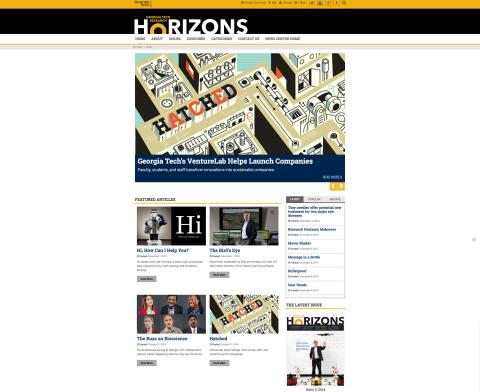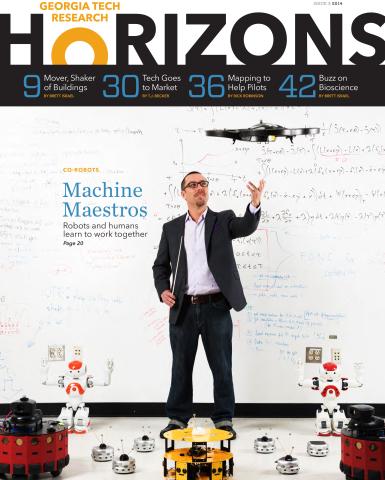Georgia Tech has launched a redesigned Research Horizons magazine, along with a new website and digital e-zine to showcase its research.
For 31 years, Research Horizons has showcased the Georgia Institute of Technology’s groundbreaking scientific and engineering research.
Now the magazine, which started as a four-page, black and white publication for the-then Engineering Experiment Station (today, Georgia Tech Research Institute), has undergone a major content update and design metamorphosis.
In the new Research Horizons, which debuted this month, readers will see a publication with more visuals — larger photographs, illustrations, and accompanying graphics — shorter, more compact stories; punchier headlines; and contemporary typefaces. The refresh is designed to present the research in a more contemporary, compelling, and engaging way.
The publication’s new look coincides with a broader strategic research marketing plan that also includes a revamped monthly electronic newsletter and a new website (www.rh.gatech.edu) with videos, real-time updates, and shareable features. And it includes the launch of a digital e-zine, through Georgia Tech’s app on the Apple storefront for iPads.
It also serves to highlight what Executive Vice President for Research Stephen E. Cross has identified as the core goals for his unit: to pursue transformative research, strengthen collaborative partnerships, and enhance the societal and economic impact of those findings.
“I see this as more than just a magazine redesign. It’s a rethinking of how we talk about and how we share research that comes out of Georgia Tech,” said Cross.
The changes follow several months of study, focus group research, and planning centered on what Research Horizons readers like, how to increase the publication’s appeal, and how to make it more attractive and useful to subscribers, according to Kirk Englehardt, Georgia Tech’s director of research communications.
One of those changes is the addition of an indexed list of Georgia Tech’s research contacts to the back of the magazine — something readers surveyed said they wanted.
Another change is story length. While still comprehensive in scope, the stories are shorter and range from 1,500 to 3,000 words — versus 8,000 to 10,000 per article — Englehardt said.
The magazine, which has a circulation of about 20,000, also reflects a greater emphasis on a broader mix of stories from Georgia Tech’s 12 core research areas. To help them focus on research of specific interest to them, website visitors can view a list of stories from each core research area.
“We try to balance different technology areas — the feature stories include life sciences, military technology, technology transfer, and robotics,” said John Toon, Research Horizons’ editor. “There’s a pretty good cross section of what Georgia Tech is all about.”
That underscores a strategic decision to broaden the magazine’s focus to appeal to business and industry, in addition to the federal government sponsors of Georgia Tech research, the original catalysts for Research Horizon’s creation in 1983.
Indeed, when Cross began overseeing research in 2010, one of his goals was to expand the scope of the work done by faculty to address the needs of business and industry, as well as government agencies such as the National Science Foundation, U.S. Department of Defense, U.S. Department of Energy, and the National Institutes of Health.
“What we set out to do was try to create a magazine that would address both groups: industrial companies that needed research and development to solve problems, and the traditional base of federal government sponsors,” said Toon.
Some of the magazine’s new section headings, “Exhibit A” and “Front Office,” for example, are designed to reflect those efforts to appeal to the industrial audience. The idea is to give industry research executives a “sneak peak” at what’s next.
The magazine’s longevity is a testament to Georgia Tech’s commitment to research and to its understanding that sharing those stories is important, said Mark Hodges, a senior research associate at the Georgia Tech Research Institute and the magazine’s first editor.
“The main reason behind this was the realization that research was becoming a bigger part of Georgia Tech,” Hodges said of the original magazine launch. “And this publication was part of increasing Georgia Tech’s profile.”
If you would like to receive Research Horizons at no cost, visit http://c.gatech.edu/rh-signup and complete the short online form. You may opt into Georgia Tech’s monthly research e-newsletter at that link, too.
You can also get up-to-the-minute Georgia Tech research news on the new Research Horizons website: www.rh.gatech.edu.
Research News
Georgia Institute of Technology
177 North Avenue
Atlanta, Georgia 30332-0181 USA
Media Relations Contacts: John Toon (jtoon@gatech.edu) (404-894-6986) or Brett Israel (brett.israel@comm.gatech.edu) (404-385-1933).
Writer: Peralte Paul
Additional Images

